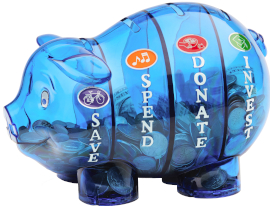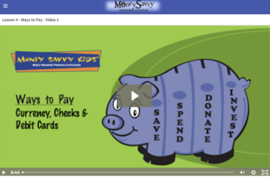The Money Savvy Kids® online program is offered in three levels. The publisher, Money Savvy Generation, recommends them for grades two through five, but I would recommend them for grades four through eight as I will explain below.
What It Covers
Money Savvy Kids is both a curriculum and an ongoing program that teaches children about the nature of money and how to manage it. This course is not just about budgeting but serves as a basic introduction to personal finance and some economic principles for children. With colorful illustrations, discussions, worksheets, activities, and practical applications, it teaches valuable concepts generally neglected in most curricula.
All students should begin with the first level (Level C) before tackling Level D and Level E. Lessons in the first level are:
- The History of Money
- Where Does Money Come From?
- Kids Can Earn Money Too
- Saving Money
- Spending Money
- Donating Money
- Investing Money
- Family Money Press Conference
Level D topics are:
- Budgeting and Choices
- Saving and Investing
- Philanthropy
- Ways to Pay
Level E topics are:
- Taxes
- Credit and Credit Cards
- Risk and Insurance
- Investing (Stock, Bonds, and Real Estate)
When topics are repeated, they cover additional material. For instance, Saving and Investing in Level C deals with bank accounts and the stock market, and Level D adds topics like certificates of deposit, compound interest, index funds, and liquidity.
Like me, you might be surprised by the topics included in courses that are supposed to be for grades two through five. Some concepts, such as budgeting, currency exchanges, the stock market, index funds, and tax deductions, seem more appropriate for older students. So I think that even the lowest level of the program is probably best for fourth grade, and students up through eighth grade are still likely to learn from all three levels. If your child has trouble with some of the lessons, you might pause at that point and work on applying what children have learned thus far, then pick up where you left off when they are more mature. (Money Savvy Generation also produces the Official Money Guide for Teenagers, which should work for students beyond eighth grade.)
In response to my misgivings about the appropriate age levels for the program, the publisher says,
"The Level C curriculum has been taught in 2nd and 3rd grade (even 1st grade) classrooms for over 20 years by educators. Investing (long-term goal) is the topic we get the most questions about, but the curriculum is intended to introduce terms to build a child’s vocabulary. We understand some 6-7 year olds may not yet be ready for Level C, but others are. From a young age, children watch their parents use money to purchase things. This curriculum provides an opportunity for children (and their parents) to talk about money—an abstract concept—in an age-appropriate and engaging way. This curriculum with the 4-chamber Money Savvy banks is a concrete way to discuss money and spark a family conversation. For reference, here is a link to the published research over the last 20 years on the Money Savvy Kids curriculum: Money Savvy Generation | Research."
While some topics are advanced, Money Savvy Kids does a good job with the basics. For example, children learn the relative values of coins and bills and that money doesn’t magically appear from ATM machines but must first be put into someone’s bank account. The course teaches about goods and services that people provide to earn money. Children begin to understand that when the money in an account is gone, you can’t take any more out until you put some back in. They learn about entrepreneurship and how to figure out if they can make a profit from a business idea. Children are encouraged to write out purchasing goals, delay gratification, and put money into a savings account so they can earn interest.
How It works
For each level, teaching is provided through eight or more videos that run five to sixteen minutes and feature cartoon illustrations, animations, voice-over instruction, and occasional songs. Near the end of each video, students are directed to pause it and discuss the three to five discussion questions on the screen with a parent or family member. For example, the second video for Lesson 1 in Level C reinforces the concept of barter by asking, “Have you ever traded something you have for something someone else has? What were those things?” Still within Level C, a question for the first video of Lesson 7 asks, “If you were to invest in a company, what types of goods would they make or services would they offer?” After the discussion, the video reviews a few new vocabulary words used in that lesson.
Information for the teacher is provided on “The Parent/Teacher Tips to Get Started” page near the beginning of each course and again in the overview at the beginning of each lesson.
Worksheets, Activities, and Quizzes
Support material is in the form of downloadable, printable pages found on “The Parent/Teacher Tips to Get Started” page as well as in the menu for each lesson. For those who don’t want to print them out, the student worksheets are also available as pre-printed books for each level (sold as a bundle of all three).
The first lesson of Level C has 20 printable pages, which is far more than the other lessons, which have from four to ten pages. The first lesson’s pages consist of nine colorful, worksheets—two with instructions for games to play with coins; a page that lists a recommended online video and describes two fun activities (a scavenger hunt and an art project); a one-page glossary of terms, such as coins, currency, quarter, and trade; a two-page recommended reading list; lyrics for a song about barter, “In Ancient Times”; and four answer key pages.
Other lessons in Level C have fewer worksheets and game instructions for students and few or no recommended books to read. (Books recommended in the first lesson might be read at any time during the course.) Level D lessons have up to 15 printable pages—more than most other lessons because there are several worksheets for budgeting, saving, and investing. Level E lessons have up to 10 pages.
In Level C, the worksheets generally require a little written work, but nothing overwhelming for younger students. For Level E, students must be familiar with multiplication, division, decimals, and percentages.
All except the last lesson in Level C have one or two online, multiple-choice quizzes. Level C quizzes have three to five questions, Level D quizzes have up to 11 questions, and Level E quizzes have up to 14. Quizzes are graded automatically, and students can retake them.
The menu on the left side of the screen walks students through each component in order, making it easy to use the program.
An optional, 24-page coloring and activity book allows younger children to participate to some extent.
Compartmentalized Piggy Banks
 While not required for the course, I think the centerpiece of the program is the Money Savvy Pig®, a large, plastic bank, available in pink, blue, purple, or green. (The bank is also available as a clear-colored cow and a soccer ball.) The bank and the set of goal-setting stickers that come with it teach children to become goal-oriented in their money handling and help them continue to apply what they have learned in the course.
While not required for the course, I think the centerpiece of the program is the Money Savvy Pig®, a large, plastic bank, available in pink, blue, purple, or green. (The bank is also available as a clear-colored cow and a soccer ball.) The bank and the set of goal-setting stickers that come with it teach children to become goal-oriented in their money handling and help them continue to apply what they have learned in the course.
The bank is divided into four sections: save, spend, donate, and invest. Lessons discuss why those four areas are important and strategies for allocating money to each one. The “donate” lessons discuss giving to charities but do not address tithing or giving specifically to church. However, the stickers include one with an image of a church, and parents can easily add that dimension during discussions about the family’s favorite charities.
Summary
Money Savvy Kids® is an interesting approach for introducing foundational ideas in economics and personal finance in elementary or middle school while also serving as a very practical tool for teaching money management.













